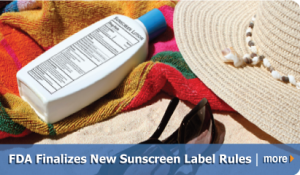
I’ve recommended several times in this blog that if you want to tan you need to fake it. I’ve discussed different ways to get a faux tan including the use of bronzers, self-tanners, and spray tans. But as many of my readers may already know the safety of spray tans has recently been called into question.
In June of this year ABC News broadcast their investigation into the dangers of DHA, the ingredient in spray tans and self tanners that gives you your tan, when inhaled. Basically, if inhaled DHA could be a possible carcinogenic. Let me be clear – you need to inhale DHA, like you would do while receiving a spray tan, in order for it to pose a health risk. Applying a self-tanning lotion to your body with DHA will not pose a cancer threat since you do not inhale the lotion through your nose, mouth, or eyes (or at least you shouldn’t if you apply it correctly).
According to the ABC News report the FDA has never approved the use of DHA in spray tans, but does allow its use in self-tanning lotions and creams, yet has not banned its use either in spray tanning. There is also little to no oversight over the tanning industry (a fact I have lamented here in my blog more than once) so that this industry can pretty get away with saying whatever they want about the safety of tanning beds (which don’t kid yourself are never safe) and spray tans. The ABC investigation included an undercover reporter who went to various tanning salons and inquired about the safety of spray tanning. Her concerns were dismissed repeatedly.
The New York Magazine piece about this controversy quotes one of the doctors seen in the ABC News report:
“I have concerns,” said Dr. Rey Panettieri, a toxicologist and lung specialist at the University of Pennsylvania’s Perelman School of Medicine. “The reason I’m concerned is the deposition of the tanning agents into the lungs could really facilitate or aid systemic absorption — that is, getting into the bloodstream. These compounds in some cells could actually promote the development of cancers or malignancies,” he said, “and if that’s the case then we need to be wary of them.”
Back in the seventies, when DHA (short for dihydroxyacetone, the chemical ingredient that darkens skin) was first approved by the FDA, it was only meant to be an ingredient in tanning creams. No one foresaw the popularity of spray tanning today, which obviously disperses DHA into the air (and, by proxy, into your lungs if you’re nearby).
“DHA should not be inhaled or ingested” today. It tells consumers on its website, “The use of DHA in ‘tanning’ booths as an all-over spray has not been approved by the FDA, since safety data to support this use has not been submitted to the agency for review and evaluation.” The agency advises consumers who spray tan they are “not protected from the unapproved use of this color additive” if they are inhaling the mist or allowing it to get inside their body. The agency recommends, “Consumers should request measures to protect their eyes and mucous membranes and prevent inhalation.”
While further studies will be conducted for more conclusive results (the original data was formulated after testing DHA on nonhuman cells), the bottom line is, be pale. You’ll look and feel much better in the long run.
(Now Spray Tanning Might Cause Cancer, Too – New York Magazine)
I always like to present two sides to every controversial topic I bring up here in my blog so I was interested to read a rebuttal to the ABC News report on the esthetician centered publication website Skin Inc. in the article Is Spray Tanning Safe?:
Many questions have recently been posed regarding a story featured by Good Morning America/ABC News regarding the safety of spray tanning. Kelly Richardson of B.Bronz offers her response to the report, and provides some tips and advice when discussing this with clients, employees and others.
The report, information and interpretations
The study that was used in the report presented by the media was done by the European Commission Scientific Study on Consumer Safety. This study was published in 2010.
The news media did not differentiate between data that was obtained for automated spray booths and for hand-held turbine devices. The hand-held turbine devices are considered to be safe and do not need/require many of the safety precautions that the automated spray booths require.
Spray tanning technique
The techniques that should be used are designed to minimize dihydroxyacetone (DHA) exposure to the clients. The suggested treatment time consists of less than two minutes of spraying with approximately 50 mL of product. The spray pattern should be designed to push the overspray to the ground, minimizing it and, lastly, it is always recommended that you do not run fans during or after the treatment, as it promotes inhalation. Also recommended is using an extraction fan if you do not have proper room ventilation.
Products
The report by the European Commission shows that high levels of DHA should not be inhaled by either the technician or the client. Most “rapid-developing” products that are on the market have active ingredient levels of 14-22%, which are considered too high for inhalation.
The U.S. Food & Drug Administration (FDA)
DHA (the same active ingredient in every self-tanner, spray tan or sunless tanning treatment) has been approved for decades by the FDA for cosmetic use. As there have been no studies on inhalation and exposure done directly by the FDA (even though the European Commission has done studies), they advise that the products should not be used in the mucous membranes. It is a good idea to have this verbiage in your client release form or available for your clients to review.
Additionally, the FDA has not studied DHA, and pregnancy or nursing. It is recommended you have clients who are pregnant or nursing to ask or get permission from their doctors before starting any tanning regimen.
Safety equipment
It is important to use a face mask or other protection when spraying. If you are spraying, especially multiple clients in a poorly ventilated area, it is crucial. Keep items stocked at your skin care facility, including lip balm, nose plugs and silicone covers for the nipple areas.
After having discussions yesterday with many spray tanners, and professionals in the industry from insurance companies and other manufacturers, most had serious questions as to whether or not eye coverings used in tanning salons for UV protection would protect for spray tanning. It was our general consensus that these products do not, and better protection would be having the customer keep their eyes closed during the treatment. I would discuss with your insurance agent and find out what they require and recommend you to have on hand for your customers.
Of course, the ABC News report gave me a lot to think about. Anytime I have a client who tells me how much they love tanning (either on the beach, by the pool, or in a tanning booth) I recommend that they get a spray tan instead. I guess I should stop giving out that recommendation or recommend that they wear a mask, nose plugs, and goggles while receiving the spray tan.
Please share your thoughts below on this controversy.
Further Reading:
Image from tareendermatology.com











Recent Comments